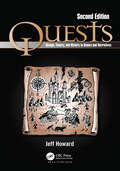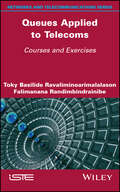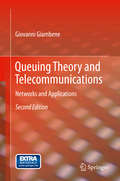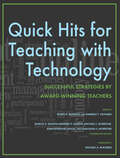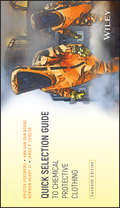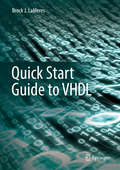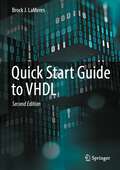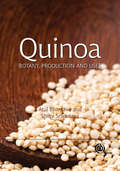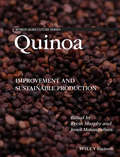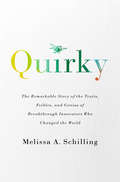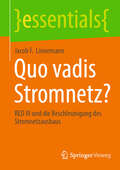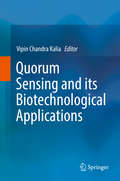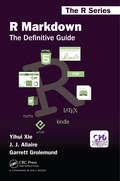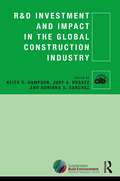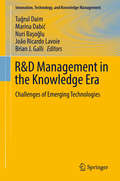- Table View
- List View
Questioning Technology
by Andrew FeenbergModern industrial society is an experiment with a brief past and an uncertain future. In less than two centuries, technology has transformed the globe and given the human race the power to realize its highest ideals or destroy itself.
Quests: Design, Theory, and History in Games and Narratives
by Jeff HowardCombining theory and practice, this updated new edition provides a complete overview of how to create deep and meaningful quests for games. It uses the Unity game engine in conjunction with Fungus and other free plugins to provide an accessible entry into quest design. The book begins with an introduction to the theory and history of quests in games, before covering four theoretical components of quests: their spaces, objects, actors, and challenges. Each chapter also includes a practical section, with accompanying exercises and suggestions for the use of specific technologies for four crucial aspects of quest design: • level design • quest item creation • NPC and dialogue construction • scripting This book will be of great interest to all game designers looking to create new, innovative quests in their games. It will also appeal to new media researchers, as well as humanities scholars in the fields of mythology and depth-psychology that want to bring computer-assisted instruction into their classroom in an innovative way. The companion website includes lecture and workshop slides, and can be accessed at: www.designingquests.com
Queues Applied to Telecoms: Courses and Exercises
by Toky Basilide Ravaliminoarimalalason Falimanana Randimbindrainibe<p> From queues to telecoms. Queues are, of course, omnipresent in our world, at the bank, the supermarket, the shops, on the road... and yes, they also exist in the domain of telecoms. <p> <p> Queues Applied to Telecoms studies the theoretical aspect of these queues, from Poisson processes, Markov chains and queueing systems to queueing networks. The study of the use of their resources is addressed by the theory of teletraffic. This book also outlines the basic ideas in the theory of teletraffic, presenting the teletraffic of loss systems and waiting systems. <p> <p> However, some applications and explanations are more oriented towards the field of telecommunications, and this book contains lectures and more than sixty corrected exercises to cover these topics. On your marks....<p>
Queuing Theory and Telecommunications
by Giovanni GiambeneThis book is aimed to provide a basic description of current networking technologies and protocols as well as to provide important tools for network performance analysis based on queuing theory. The second edition adds selected contents in the first part of the book for what concerns: (i) the token bucket regulator and traffic shaping issues; (ii) the TCP protocol congestion control that has a significant part in current networking; (iii) basic satellite networking issues; (iv) adding details on QoS support in IP networks. The book is organized so that we have first networking technologies and protocols (Part I) and then theory and exercises with applications to the different technologies and protocols (Part II). This book is intended as a textbook for master level courses in networking and telecommunications sectors.
Queuing Theory and Telecommunications: Networks and Applications (Textbooks in Telecommunication Engineering)
by Giovanni GiambeneThis thoroughly revised textbook provides a description of current networking technologies and protocols as well as important new tools for network performance analysis based on queuing theory. The third edition adds topics such as network virtualization and new related architectures, novel satellite systems (such as Space X, OneWeb), jitter and its impact on streaming services, packet level FEC techniques and network coding, new Markovian models, and advanced details on M/G/1 queuing models. The author also adds new selected exercises throughout the chapters and a new version of the slides and the solution manual. The book maintains its organization with networking technologies and protocols in Part I and then theory and exercises with applications to the different technologies and protocols in Part II. This book is intended as a textbook for master level courses in networking and telecommunications sectors.
Quick Hits for Teaching with Technology: Successful Strategies by Award-Winning Teachers
by Marcia D. Dixson Andrew D. Gavrin Michael C Morrone Joan E Lafuze Anastasia S Morrone“A wealth of good ideas” for using technology in education, from increasing student engagement to managing hybrid and distance learning (Teachers College Record).How should I use technology in my courses? What impact does technology have on student learning? Is distance learning effective? Should I give online tests and, if so, how can I be sure of the integrity of the students’ work? These are some of the questions that instructors raise as technology becomes an integral part of the educational experience.In Quick Hits for Teaching with Technology, award-winning instructors representing a wide range of academic disciplines describe their strategies for employing technology to achieve learning objectives. They include tips on using just-in-time teaching, wikis, clickers, YouTube, blogging, and GIS, to name just a few. An accompanying interactive website enhances the value of this innovative tool.
Quick Selection Guide to Chemical Protective Clothing
by James P. Zeigler Krister Forsberg Norman Henry III Ann Van den BorreQuick Selection Guide to Chemical Protective Clothing provides the reader with the latest information on Selection, Care and Use of Chemical Protective garments and gloves. Topics in the widely-used reference guide include Selection and Use of Chemical Protective Clothing, Chemical Index, Selection Recommendations, Glossary, Standards for Chemical Protective Clothing, Manufactures of Chemical Protective Clothing and European requirements for chemical resistant gloves.The key feature of the book is the color-coded selection recommendations. The red, yellow or green indications are highly appreciated by the users. This sixth edition of the Quick Selection Guide to Chemical Protective Clothing has been updated, to include approximately 1,000 chemicals/chemical brands or mixture of chemicals more than twice the information provided in the original edition. The performance of 9 generic materials and 32 proprietary barriers are compared against the 21 standard test chemicals listed in ASTM F1001. The color-coded recommendations against the broader list of materials now contain 27 representative barrier materials. This best selling pocket guide is the an essential field source for HazMat teams, spill responder, safety professionals, chemists and chemical engineers, industrial hygienists, supervisors, purchase agents, salespeople and other users of chemical protective clothing.
Quick Selection Guide to Chemical Protective Clothing
by James P. Zeigler Krister Forsberg Norman Henry III Ann Van den BorreThe expanded seventh edition, complete with new materials and updated information on existing materials for chemical protective clothing The revised and updated seventh edition of Quick Selection Guide to Chemical Protective Clothing contains the most recent information on the selection, use, and care of chemical protective clothing, such as protective gloves, suits, and other garments. The seventh edition includes new selection recommendations, new materials and chemicals tested, and updated information on existing products. This accessible guide also contains the popular color-coded selection grid. The grid system indicates which materials offer protection against specific chemicals, and which do not. Selecting the most appropriate chemical protective clothing is essential for the prevention of illnesses and injures from hazardous chemical exposure, especially where other control measures are not feasible. Written by noted experts on the topic, the book has been thoroughly revised to reflect the most recent advances in the field. The new seventh edition: • Offers an updated Trade Name Table with 25 product name changes, 8 new products, and 10 products deletions • Includes 27 products in the Master Chemical Resistance Table with changed names and includes replaces outdated products with important new ones • Contains new selection recommendations (color codes) that reflect new chemicals and additional tests • Includes 1,000 chemicals in the index that are linked to the UN pictograms and Risk Codes related to skin exposure • Provides a guide for comparing the performance of available product/barrier materials currently on the market Written for anyone responsible for the purchase or use of protective clothing, the updated seventh edition of Quick Selection Guide to Chemical Protective Clothing is a pocket guide that is the only independent source for selection of chemical protective clothing.
Quick Start Guide to VHDL
by Brock J. LaMeresThis textbook provides a starter’s guide to VHDL. This book can be used in conjunction with a one-semester course in Digital Systems Design or on its own for designers who only need an introduction to the language. This book is designed to provide a bottoms-up approach to learning the VHDL language. This design supports a course in which foundational knowledge is covered before moving into advanced topics. However, this design also supports use as a reference manual. The author has designed the presentation with learning goals and assessment at its core. Each section addresses a specific learning outcome that the student should be able to “do” after its completion. The concept checks and exercise problems provide a rich set of assessment tools to measure student performance on each outcome.
Quick Start Guide to VHDL
by Brock J. LaMeresThis textbook provides a starter’s guide to VHDL. This book can be used in conjunction with a one-semester course in Digital Systems Design or on its own for designers who only need an introduction to the language. This book is designed to provide a bottoms-up approach to learning the VHDL language. This design supports a course in which foundational knowledge is covered before moving into advanced topics. However, this design also supports use as a reference manual. The author has designed the presentation with learning goals and assessment at its core. Each section addresses a specific learning outcome that the student should be able to “do” after its completion. The concept checks and exercise problems provide a rich set of assessment tools to measure student performance on each outcome.
Quick Start Guide to Verilog
by Brock J. LaMeresThis textbook provides a starter’s guide to Verilog, to be used in conjunction with a one-semester course in Digital Systems Design, or on its own for readers who only need an introduction to the language. This book is designed to match the way the material is actually taught in the classroom. Topics are presented in a manner which builds foundational knowledge before moving onto advanced topics. The author has designed the presentation with learning goals and assessment at its core. Each section addresses a specific learning outcome that the student should be able to “do” after its completion. The concept checks and exercise problems provide a rich set of assessment tools to measure student performance on each outcome.Written the way the material is taught, enabling a bottom-up approach to learning which culminates with a high-level of learning, with a solid foundation;Emphasizes examples from which students can learn: contains a solved example for nearly every section in the book;Includes more than 200 exercise problems, as well as concept check questions for each section, tied directly to specific learning outcomes.
Quicksilver Mining in Sonoma County: Pine Flat Prospect Fever
by Joe PelanconiIn the 1870s, a quicksilver mining boom took hold of Sonoma County, California. Claims were staked, and a rowdy camp took shape in Pine Flat as farmers traded plows for picks and miners answered the siren call of cinnabar. In this compelling account, historian Joe Pelanconi relates the development of the twenty-mile Cinnabar Mining District. Pelanconi shares intriguing stories like those of the Donner Party survivor, Chinese laborers who worked the mines in danger of mercury poisoning and the two brothers who were leading citizens of the district and purported victims of murder. Delve into Sonoma County's heritage and a lost era when eccentrics and dreamers sought shining flasks of riches in the Mayacamas Mountains above today's wine country.
Quinoa
by Shilpi Srivastava Didier Bazile Enrique A Martínez Atul Bhargava Francisco Fuentes* Quinoa is an invaluable crop, highlighted by the FAO as one of the world's main crops for future food security * Timely publication - The year 2013 has been declared "The International Year of the Quinoa" (IYQ), recognizing the Andean indigenous peoples, who have maintained, controlled, protected and preserved quinoa as food for present and future generations thanks to their traditional knowledge and practices of living well in harmony with mother earth and nature. * Covers the history, phylogeny and systematics, botany and agrotechnology
Quinoa
by Kevin S. Murphy Janet MatanguihanQuinoa is an ancient grain that has grown in popularity in recent years. It has been known as a good source of both protein and fiber. As the demand for quinoa increases a comprehensive and up-to-date reference on the biology and production of the crop is essential. Quinoa: Improvement and Sustainable Production brings together authors from around the world to provide a complete assessment of the current state of global quinoa research and production. Topics covered include quinoa history and culture, genomics and breeding, agronomy, nutrition, marketing, and end-uses. The book focuses in particular on the emerging role of quinoa in providing increased food security to smallholder farmers and communities throughout the world. Quinoa will interest quinoa researchers, producers, crop scientists, agronomists, and plant geneticists, as well as advanced students working with this important grain.
Quinoa: Botany, Production and Uses (Botany, Production and Uses)
by Shilpi Srivastava Atul Bhargava* Quinoa is an invaluable crop, highlighted by the FAO as one of the world’s main crops for future food security * Timely publication – The year 2013 has been declared "The International Year of the Quinoa" (IYQ), recognizing the Andean indigenous peoples, who have maintained, controlled, protected and preserved quinoa as food for present and future generations thanks to their traditional knowledge and practices of living well in harmony with mother earth and nature. * Covers the history, phylogeny and systematics, botany and agrotechnology
Quirky: The Remarkable Story of the Traits, Foibles, and Genius of Breakthrough Innovators Who Changed the World
by Melissa A SchillingThe science behind the traits and quirks that drive creative geniuses to make spectacular breakthroughsWhat really distinguishes the people who literally change the world--those creative geniuses who give us one breakthrough after another? What differentiates Marie Curie or Elon Musk from the merely creative, the many one-hit wonders among us?Melissa Schilling, one of the world's leading experts on innovation, invites us into the lives of eight people--Albert Einstein, Benjamin Franklin, Elon Musk, Dean Kamen, Nikola Tesla, Marie Curie, Thomas Edison, and Steve Jobs--to identify the traits and experiences that drove them to make spectacular breakthroughs, over and over again. While all innovators possess incredible intellect, intellect alone, she shows, does not create a breakthrough innovator. It was their personal, social, and emotional quirkiness that enabled true genius to break through--not just once but again and again.Nearly all of the innovators, for example, exhibited high levels of social detachment that enabled them to break with norms, an almost maniacal faith in their ability to overcome obstacles, and a passionate idealism that pushed them to work with intensity even in the face of criticism or failure. While these individual traits would be unlikely to work in isolation--being unconventional without having high levels of confidence, effort, and goal directedness might, for example, result in rebellious behavior that does not lead to meaningful outcomes--together they can fuel both the ability and drive to pursue what others deem impossible. Schilling shares the science behind the convergence of traits that increases the likelihood of success. And, as Schilling also reveals, there is much to learn about nurturing breakthrough innovation in our own lives--in, for example, the way we run organizations, manage people, and even how we raise our children.
Quo Vadis Common Fisheries Policy?
by Ernesto Penas LadoOffers a guide and provides an analysis of how a public European fisheries policy should be evaluated, implemented, and reformed Quo Vadis Common Fisheries Policy? is an essential book that provides an authoritative guide to the future challenges that face the public European fisheries policy. Written by a noted expert with 30 years’ experience in fisheries policies, the book provides the information needed to analyze how a public EU policy should be evaluated, implemented, and reformed. The book examines the difficulties of implementing the new policy including the application of the objectives of the 2013 policy reform. The author explores the myriad challenges that face the new policy due to global warming, pollution, and other global drivers. The book compares the new policy with other fisheries policy, particularly with the United States fisheries policy under the Magnusson-Stevens Act. The book offers an opportunity to address and discuss the challenges and obstacles that are not currently in the public domain. This important book: Provides a unique view from a noted expert and former policy insider Offers a critical analysis of a public EU policy from a pro-European standpoint. Gives a foundational resource to aid in the debate on the future of the Common Fisheries Policy Includes topics that go beyond EU’s policy and have implications for fisheries’ management around the world Written for administrations and stakeholders in the European and international fishing industry, Quo Vadis Common Fisheries Policy? addresses the challenges of EU’s new fisheries policy and offers a comparison of the US fisheries policy. The book helps foster much-needed debate about this topic.
Quo Vadis: Evolution of Modern Navigation
by F. G. MajorQuo Vadis: Evolution of Modern Navigation presents an intelligent and intelligible account of the essential principles underlying the design of satellite navigational systems--with introductory chapters placing them in context with the early development of navigational methods. The material is organized roughly as follows: the first third of the book deals with navigation in the natural world, the early history of navigation, navigating by the stars, precise mechanical chronometers for the determination of longitude at sea, and the development of precise quartz controlled clocks. Then, the reader is introduced to quantum ideas as a lead in to a discussion of microwave and optical interactions with atoms, atomic clocks, laser gyrocompasses, and time based navigation. The final third of the book deals with satellite-based systems, including orbit theory, early satellite navigation systems, and a detailed treatment of the Global Positioning System (GPS). Intended for non-specialists with some knowledge of physics or engineering at the college level, this book covers in an intuitive manner a broad range of topics relevant to the evolution of surface and space navigation, with minimum mathematical formalism.
Quo vadis Stromnetz?: RED III und die Beschleunigung des Stromnetzausbaus (essentials)
by Jacob F. LinnemannDer Stromnetzausbau ist essenziell für das Gelingen der Energiewende in Deutschland. Um die komplexen Planungs- und Genehmigungsverfahren hierfür zu beschleunigen, hat der europäische Gesetzgeber mit der novellierten Erneuerbare-Energien-Richtlinie (RED III) einen grundlegend neuen Weg eingeschlagen. Was verändert sich durch RED III und die nationale Umsetzung in Deutschland beim Stromnetzausbau? Wie wirken sich die Neuregelungen auf die Beschleunigung aus? Nach einem Überblick über die Inhalte der Richtlinie und der geplanten Umsetzung in Deutschland wird der Blick auf die Praxis gerichtet. Aktuelle Einschätzungen zu den Neuregelungen aus verschiedenen Perspektiven zeigen unterschiedliche Sichtweisen und Erwartungen. Einige wesentliche Aspekte können dabei für die Beschleunigungswirkung der neuen Regelungen entscheidend sein.
Quorum Sensing and its Biotechnological Applications
by Vipin Chandra KaliaThis book delves into the biotechnological applications of Quorum sensing (QS)- a peculiar gene-regulatory process of some microorganisms. Quorum Sensing allows a large bacterial population to work together in a coordinated manner to carry out metabolic activities, which individual bacterium cannot. The different chapters describe how, associating bioremediation process with energy generation is an economical proposal, for reducing pollution and managing biowastes. The book discusses how QS can be exploited for biotechnological applications in generating bioproducts, bioenergy, bioremediation, biosensors, health and agricultural activities. It further highlights how QS is becoming an integral part of synthetic biology for genetic circuits for producing: (i) novel products, (ii) biosensors, (iii) bioactive molecules, etc. The book is divided into different sections for a clear understanding of the applicability of QS in, the Environment, Energy, Agriculture and Health sectors.
R Applications in Earth Sciences: From Soil Data to Climate Time Series Analysis and Modeling (Springer Textbooks in Earth Sciences, Geography and Environment)
by Łukasz PawlikThis textbook helps to understand the real Earth data with the practical application of many handy R tools and techniques. R language and thousands of R packages can be used to solve the most sophisticated scientific problems. The book provides insights to the various approaches to Earth-related data analysis, starting from data preparation and validation, exploratory data analysis, linear regression, and going through time series decomposition, modeling, and prediction. In addition, the book introduces machine learning techniques and their application to some real problems. Along with a profound explanation of the datasets and theoretical considerations of the methods, the book offers a way of solving practical problems lying at the frontline of modern data analysis in physical geography, soils, and climate science.
R Markdown: The Definitive Guide (Chapman & Hall/CRC The R Series)
by Garrett Grolemund J. J. Allaire Yihui Xie<p>R Markdown: The Definitive Guide is the first official book authored by the core R Markdown developers that provides a comprehensive and accurate reference to the R Markdown ecosystem. With R Markdown, you can easily create reproducible data analysis reports, presentations, dashboards, interactive applications, books, dissertations, websites, and journal articles, while enjoying the simplicity of Markdown and the great power of R and other languages. <p>In this book, you will learn <p> <li>Basics: Syntax of Markdown and R code chunks, how to generate figures and tables, and how to use other computing languages <li>Built-in output formats of R Markdown: PDF/HTML/Word/RTF/Markdown documents and ioslides/Slidy/Beamer/PowerPoint presentations <li>Extensions and applications: Dashboards, Tufte handouts, xaringan/reveal.js presentations, websites, books, journal articles, and interactive tutorials <li>Advanced topics: Parameterized reports, HTML widgets, document templates, custom output formats, and Shiny documents. </p></li> <P><P><i>Advisory: This book offers only partial accessibility. We have kept it in the collection because it is useful for some of our members. Benetech is actively working on projects to improve accessibility issues such as these in the future.</i>
R for Everyone: Advanced Analytics and Graphics, Second Edition
by Jared P. LanderStatistical Computation for Programmers, Scientists, Quants, Excel Users, and Other Professionals Using the open-source R language, you can build powerful statistical models to answer many of your most challenging questions. R has traditionally been difficult for non-statisticians to learn, and most R books assume far too much knowledge to be of help. R for Everyone, Second Edition, is the solution. Drawing on his unsurpassed experience teaching new users, professional data scientist Jared P. Lander has written the perfect tutorial for anyone new to statistical programming and modeling. Organized to make learning easy and intuitive, this guide focuses on the 20 percent of R functionality you’ll need to accomplish 80 percent of modern data tasks. Lander’s self-contained chapters start with the absolute basics, offering extensive hands-on practice and sample code. You’ll download and install R; navigate and use the R environment; master basic program control, data import, manipulation, and visualization; and walk through several essential tests. Then, building on this foundation, you’ll construct several complete models, both linear and nonlinear, and use some data mining techniques. After all this, you’ll make your code reproducible with LaTeX, RMarkdown, and Shiny. By the time you’re done, you won’t just know how to write R programs, you’ll be ready to tackle the statistical problems you care about most.
R&D Investment and Impact in the Global Construction Industry (Cib Ser.)
by Adriana X. Sanchez Keith D. Hampson Judy A. KraatzR&D Investment and Impact in the Global Construction Industry brings together contributions from leading industry researchers in a diverse group of countries to investigate the role of research and development (R&D) in the construction industry. Investment in R&D is a proven factor in economic growth, and helps develop a more productive and innovative industry. This book explores how policy makers and industry leaders can better target future investment; and how industry and researchers can manage their efforts to improve productivity whilst addressing the environmental and social needs of their communities. Case studies present projects where R&D ideas funded by both the private and public sectors have been translated from research into practice or policy, and examine drivers, successes and barriers to the delivery of R&D in industry. Based on research from members of the CIB Task Group 85 (R&D Investment and Impact) and concluding with key insights for maximising the impact of R&D in the future, the book holds valuable lessons for practitioners, policy makers and researchers across the international construction industry.
R&D Management in the Knowledge Era: Challenges of Emerging Technologies (Innovation, Technology, and Knowledge Management)
by Tuğrul Daim Marina Dabić Nuri Başoğlu João Ricardo Lavoie Brian J. GalliThis volume explores emerging models, methods and tools in the management of research and development (R&D) in the knowledge era, with a particular focus on the challenges of the emerging technologies. The contributions are organized in five parts. Part I, Managing Emerging Technologies, provides methods and tools to understand the challenges created by the emergence of new technologies. Part II, Technology and Engineering Management Tools and Policies, explores different technology and engineering tools, including topics such as product concept development, design, selection and adoption, using technology roadmaps and bibliometrics. Part III, Technological Innovation and Entrepreneurship, explores R&D, knowledge transfer and entrepreneurial education. Part IV, Commercialization of Technological Innovations, explores the development and application of the technology transfer process which allows managers to succeed in commercializing the outcomes of R&D projects. Part V, Managing the Engineering Enterprise, explores the effect economic decision-making, leadership styles, change management and quality management have on an organization’s ability to plan and execute initiatives and projects. Research and Development has always played a critical role in the engineering and technology focused industries. In an era of big data and smart applications, knowledge has become a key enabler for R&D. Managing R&D in the knowledge era requires use of key tools and methods. However, emerging technologies pose many challenges and cause uncertainties or discontinuities, which make the task of managing R&D even more difficult. This book will examine these challenges and provide tools and methods to overcome them. Exploring such industries as automotive, healthcare, business intelligence, energy and home appliances, this book is a valuable resource for academics, scholars, professionals and leaders in innovation, R&D, technology, and engineering management.

